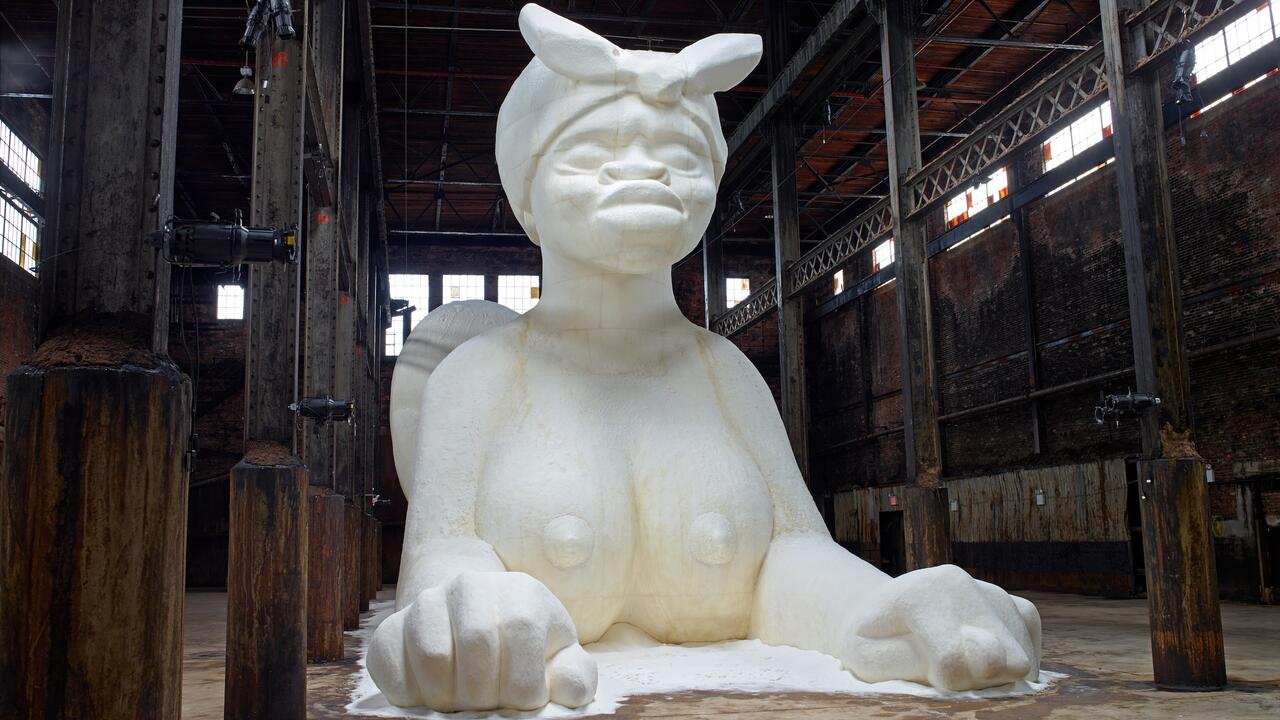Décor
Villa Empain, Boghossian Foundation, Brussels, Belgium
Villa Empain, Boghossian Foundation, Brussels, Belgium

The Villa Empain, built between 1930 and 1934 by Swiss architect Michel Polak and home to the Boghossian Foundation since its recent renovation, is a handsome confluence of Art Deco curves, clean lines and opulent surfaces. ‘Decor’, curated by the Foundation’s Artistic Director Asad Raza, along with artist Tino Sehgal and curator Dorothea von Hantelmann, adds another layer of sumptuousness. Entering the central atrium through Felix Gonzalez-Torres’s golden bead curtain (Untitled [Golden], 1995), you find a quintet of Andy Warhol’s soft, helium-filled Silver Clouds (1966), performing a lazy dance above a well-placed Carl Andre floor piece, which echoes in lead the marble tiles on which it lies. At the far end of the building, the windows looking onto an impossibly glamorous pool have been covered by Daniel Buren in vertical white stripes and square lozenges in primary colours, which cast harlequin patterns onto a Rosemarie Trockel rug (Woolmark [Orange], 1990). In the polished wood bar to the left of the atrium is a large aquarium courtesy of Pierre Huyghe (Cambrian Explosion 14, 2016), home to assorted ancient-looking sea creatures that scuttle beneath a massive lava stone hovering mysteriously in the water.

In hosting an exhibition of works that function equally well as interior design, the villa is also put on display. The exhibits, in turn, enact a subtle kind of drag, shedding their conceptual credentials to be just a carpet, a curtain, an extravagant flower arrangement (Jeroen de Rijke and Willem de Rooij, Bouquet II, 2003). This vacillation in the objects’ status is ramped up on the first floor in works by Jorge Pardo and Dominique Gonzalez-Foerster, both veterans of such genre-crossing. Pardo’s arrangement of vinyl cord chairs and ceramic lamps seems right at home in these luxurious surroundings, while a couple of books left on the matching table (all Untitled, 2014) suggest the presence of a notional inhabitant.
Gonzalez-Foerster’s Chambre (l’inhumaine) (Room [The Inhuman Woman], 2016) elaborates the idea of a fictional character, creating an imaginary boudoir for silent movie star Georgette Leblanc, all plush carpet, fur bedspreads and drawn curtains, the clock stopped perpetually at a minute before ten. This is the first ‘Chambre’ the artist has made since the mid-1990s, the villa presumably having offered a perfect opportunity to return to this format of biography-through-furnishing.
However well-paced and cleverly put together, this show’s addressing of the overlap of public and private realms does not take into account the 30 years that have passed since Jan Hoet’s ground-breaking ‘Chambres d’Amis’ exhibition in Ghent in 1986, which scattered a group show through dozens of private residences throughout the city; nor the 45 years since Daniel Buren’s systematic enquiry into the unspeakable compromise of the ‘portable work of art’; nor, indeed, the 25 years since many of its participants began playing with ‘relational aesthetics’. How necessary is it now to talk about ‘weakening art’s so-called autonomy’, after decades of systematic deconstruction of this notion? What about Lucy McKenzie’s recent destabilizing of luxury and interior design through her trompe l’oeil sculpture/furniture hybrids? Or Marc Camille Chaimowicz’s decorative reworkings of exhibition interiors to carve out zones of androgyny? Or Elmgreen and Dragset’s narrative-driven curatorial mises-en-scène? Works by Waqas Khan and Monir Shahroudy Farmanfarmaian attempt to open up the context to account for Eastern notions of the decorative in art, but seem more like token gestures aimed at satisfying the Boghossian Foundation’s aim to be a ‘centre for art and dialogue between East and West’.

The sumptuous surface of this exhibition cracks on closer inspection. Instead of investigating art’s social capacities and any attendant political implications, it is primarily an exhibition as movie set, where reality and fiction overlap. Its success lies in being, as the press release states, ‘an exhibition about the decorative in modern and contemporary art, and at the same time simply a decoration of the villa’.





















